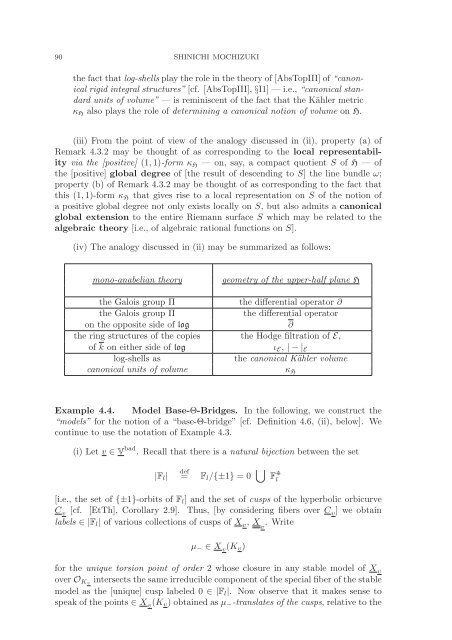Inter-universal Teichmuller Theory I: Construction of Hodge Theaters
Inter-universal Teichmuller Theory I: Construction of Hodge Theaters
Inter-universal Teichmuller Theory I: Construction of Hodge Theaters
Create successful ePaper yourself
Turn your PDF publications into a flip-book with our unique Google optimized e-Paper software.
90 SHINICHI MOCHIZUKI<br />
the fact that log-shells play the role in the theory <strong>of</strong> [AbsTopIII] <strong>of</strong> “canonical<br />
rigid integral structures” [cf. [AbsTopIII], §I1] — i.e., “canonical standard<br />
units <strong>of</strong> volume” — is reminiscent <strong>of</strong> the fact that the Kähler metric<br />
κ H also plays the role <strong>of</strong> determining a canonical notion <strong>of</strong> volume on H.<br />
(iii) From the point <strong>of</strong> view <strong>of</strong> the analogy discussed in (ii), property (a) <strong>of</strong><br />
Remark 4.3.2 may be thought <strong>of</strong> as corresponding to the local representability<br />
via the [positive] (1, 1)-form κ H —on,say,acompactquotientS <strong>of</strong> H —<strong>of</strong><br />
the [positive] global degree <strong>of</strong> [the result <strong>of</strong> descending to S] the line bundle ω;<br />
property (b) <strong>of</strong> Remark 4.3.2 may be thought <strong>of</strong> as corresponding to the fact that<br />
this (1, 1)-form κ H that gives rise to a local representation on S <strong>of</strong> the notion <strong>of</strong><br />
a positive global degree not only exists locally on S, but also admits a canonical<br />
global extension to the entire Riemann surface S which may be related to the<br />
algebraic theory [i.e., <strong>of</strong> algebraic rational functions on S].<br />
(iv) The analogy discussed in (ii) may be summarized as follows:<br />
mono-anabelian theory<br />
geometry <strong>of</strong> the upper-half plane H<br />
the Galois group Π<br />
the differential operator ∂<br />
the Galois group Π<br />
the differential operator<br />
on the opposite side <strong>of</strong> log<br />
∂<br />
the ring structures <strong>of</strong> the copies the <strong>Hodge</strong> filtration <strong>of</strong> E,<br />
<strong>of</strong> k on either side <strong>of</strong> log<br />
ι E , |−| E<br />
log-shells as<br />
the canonical Kähler volume<br />
canonical units <strong>of</strong> volume<br />
κ H<br />
Example 4.4. Model Base-Θ-Bridges. In the following, we construct the<br />
“models” for the notion <strong>of</strong> a “base-Θ-bridge” [cf. Definition 4.6, (ii), below]. We<br />
continue to use the notation <strong>of</strong> Example 4.3.<br />
(i) Let v ∈ V bad . Recall that there is a natural bijection between the set<br />
|F l |<br />
def<br />
= F l /{±1} =0 ⋃ F l<br />
[i.e., the set <strong>of</strong> {±1}-orbits <strong>of</strong> F l ] and the set <strong>of</strong> cusps <strong>of</strong> the hyperbolic orbicurve<br />
C v [cf. [EtTh], Corollary 2.9]. Thus, [by considering fibers over C v ] we obtain<br />
labels ∈|F l | <strong>of</strong> various collections <strong>of</strong> cusps <strong>of</strong> X v , X v<br />
.Write<br />
μ − ∈ X v (K v )<br />
for the unique torsion point <strong>of</strong> order 2 whose closure in any stable model <strong>of</strong> X v<br />
over O Kv intersects the same irreducible component <strong>of</strong> the special fiber <strong>of</strong> the stable<br />
model as the [unique] cusp labeled 0 ∈|F l |. Now observe that it makes sense to<br />
speak <strong>of</strong> the points ∈ X v (K v ) obtained as μ − -translates <strong>of</strong> the cusps, relativetothe
















